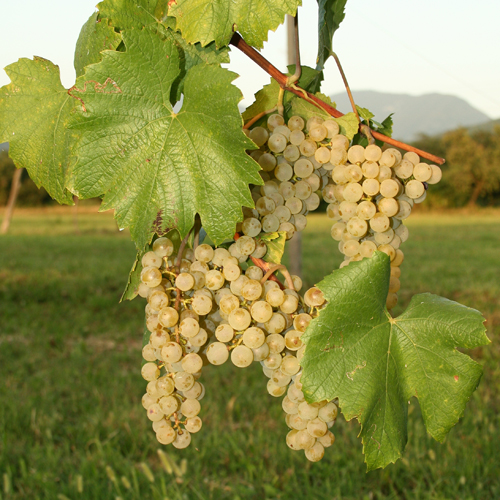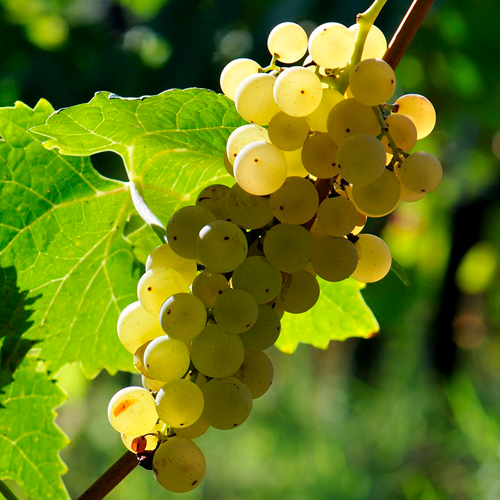Bianca grape variety
The appearance on the European continent of typical American diseases and pests of the vine, such as mildew, oidium, phylloxera, caused a protracted crisis in the wine industry in the 19th century, which continued until scientists discovered the fungicidal effect of various chemicals, and local varieties of berries ”were not cultivated on phylloxera-resistant rootstocks.

However, in parallel with the search for effective means of protection against pathogens, a number of researchers set themselves the task of developing a new type of varieties that would have the quality of the noble European grapes Vitis vinifera and resistance at the level of American native species. The first experiments of this kind, as a result of which the so-called. “Direct producers' hybrids” were not very successful, as the wines produced from these varieties turned out to be watery, flat and lackluster. The results improved gradually, as the crosses became more complex, as a result of which the DNA of new forms was saturated with genes of several different grape species at once. Especially in this matter, the originators from France Bertil Seyve and Victor Villard succeeded, who managed to create relatively high-quality and unpretentious varieties that are still cultivated in a number of states.
The Saive Villard hybrids also played a huge role in the subsequent breeding studies of scientists from many countries, especially from Eastern Europe. One of the excellent, complex resistant wine varieties obtained in this way is Bianca. She was born back in 1963 in Hungary, based on the crossing of Villard Blanc with Chassela Bouvier, produced by employees of the local Institute of Fruit Growing. The grape was originally named Egri Csillagok 40, which means "star of Eger". Eger is the name of the area where the novelty came from, and 40 is its working code, obtained at the Institute. The official name Bianca was given in 1982, after receiving official permission to produce wines from it. The quality of these drinks is also confirmed by the fact that Hungary managed to defend its right to use the variety in winemaking even after the country's accession to the European Union, where such issues are extremely sensitive.
Bianchi's resistance to the development of pathogens is positively influenced by the genes of the American species V. Labrusca, V. rupestris, V. Berlandieri and V. Lincecumii transmitted to her from the maternal form. They also determine the increased frost resistance of plants, and even tolerance to the root phylloxera. In general, this unpretentiousness determined the sincere respect for the variety of many winegrowers.
Outside of its homeland, the variety is currently distributed in Poland, Germany and the post-Soviet space. In Russia, Bianca has been included in the State Register of Breeding Achievements since 1993, and is recommended for cultivation in the North Caucasus and Central Black Earth regions. In the Krasnodar Territory alone, more than 2 thousand hectares of land have been allocated for it. Amateurs in our country also keep up with the production workers, actively cultivating a magnificent Hungarian guest in their plots in a variety of natural and climatic conditions.

Agrobiological properties
The bushes are characterized by moderate vigor. Shoots develop erect, forming an openwork crown. Leaves are medium-sized, rounded, three- or five-lobed with an average degree of dissection. The upper side of the leaf blades is smooth, light green with veins differing by several tones, the profile is wavy or funnel-shaped due to the raised edges of the blades. Dorsum pubescence is absent. Upper side cutouts of medium depth, can differ in a wide variety of shapes: closed with an ovoid lumen, open slit-like or in the form of a reentrant corner.The lower notches are small, often barely outlined, or absent altogether. The petiole notch is usually open, vaulted, with a flat or rounded bottom. The petioles are rather long, green, but often with a reddish tint. The teeth along the edge of the leaf are large, triangular for the most part, have straight edges and pointed tops. The flowers are bisexual, due to which they are characterized by good fruit set, which are not prone to peas. The shedding of inflorescences and ovaries also usually does not occur, and only in the coldest seasons, some of the flowers may not open, and then fall unpolished. The vine ripens well, almost the entire length. After ripening, the shoots acquire a rich brown color.
Cylindrical or cylindrical-conical clusters grow small. Their average weight does not exceed 100 - 120 grams, which is why labor costs during harvesting slightly increase. The structure is loose, and therefore freely located berries are not damaged against each other, and do not deform. The comb is short, herbaceous, light green in color. The grapes are small and medium, round or slightly oval, when ripe they are colored greenish-yellow with a light layer of light prune on the surface. The weight of 100 berries is 140 - 150 grams. The pulp of the fruit is slightly fleshy, but very juicy, the taste is fresh, neutral, at the same time very harmonious, the aroma is light varietal. The juice yield reaches excellent values - up to 80% of the total crop mass. The sugar content of freshly squeezed wort depends on the harvest time and can reach high levels of 26 - 28 g / 100 ml. At the same time, the titratable acidity gradually decreases from more than nine percent at the initial stage of ripening of the bunches, to less than seven in the conditions of late harvest. The skin of the grapes is not very thin, but tender, easily torn. There are seeds, but their mass fraction in fruits does not exceed a few percent.

The harvest is intended for the production of wines of the same quality as those made from classic European grape varieties. Depending on the degree of ripeness of the raw materials, dry, fortified or dessert drinks, and often cognac distillates, are produced from Bianchi. Varietal wines are distinguished by an unobtrusive floral aroma and a fresh, relatively neutral taste, which makes them excellent for blending with other varieties, mutually enriching the final bouquet. Drinks with sufficient acidity are well suited to aging in oak barrels, resulting in noticeable honey tones. In the process of processing grapes, the main thing is to minimize contact with oxygen, because both wort and wine are very susceptible to oxidation, which can spoil the color of the finished drink. The variety can also be widely used in the production of soft drinks - juices and nectars.
An excellent property of the Hungarian guest is early maturity, which allows you to cultivate it and get decent results in a variety of regions, including those where many other varieties simply would not ripen. Thus, no more than 120 days pass from the beginning of bud opening in spring until the onset of the first stage of technical maturity, and during this short growing season the plants need a rather modest amount of heat. The sum of active temperatures during early harvesting of grapes is 2400 - 2500 ° C, and in the case of late harvest it can reach 2800 - 2900 ° C. Thus, grapes of quite decent technological quality can be obtained to the north of the zones traditional for winemaking, in particular, in the Central Black Earth Region. However, here the plants will need shelter for the aboveground part of the bushes for the winter, while in the south the frost resistance, increased to −25 ... −27 ° С, makes it possible to do without insulation.
Despite the small bunch, the yield of Bianca grapes turns out to be very decent, primarily due to the almost 100% fruitfulness of the shoots and a high fruiting rate. So, on average, up to two bunches are formed on each developed shoot. This ensures the productivity of at least 5 kg of grapes from an adult bush, or 120 - 130 centners per hectare of vineyard.In advanced farms, the yield reaches 200 c / ha, and in the conditions of household plots with good care and high agricultural technology - more than 10 kg per plant. It is worth, however, to warn winegrowers against abuse of the generosity of the variety. An excessive load of eyes and shoots will inevitably lead to such negative consequences as a decrease in the growth energy of the vine, a deterioration in its ripening, and an extension of the growing season
Bianchi bunches can remain on the vine for a long time after the first signs of maturity. At the same time, the berries will continue to accumulate sugar, gradually reducing the acidity. There should be no reason for worrying about possible cracking of the fruit, because the variety is resistant in this respect. In addition, it is not susceptible to gray rot, as well as other fungal diseases, against which only single treatments may be required, and even then, in the most unfavorable damp and cold years. A remarkable property is the tolerance to the root phylloxera, which makes it possible to cultivate plants in a self-rooted culture even in the zone of continuous infection with this malicious pest. Certain protection procedures may only be required in the event of a wasp invasion. To do this, they collect and destroy the nests of these insects in the vineyard, set up special traps, or containers with fermenting compote, in which wasps drown en masse. The limited use of chemicals in the vineyard allows you to achieve excellent results, primarily in terms of the environmental friendliness of the products obtained. For this, Bianca is especially appreciated by lovers of organic farming.








